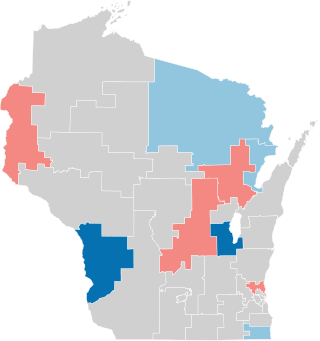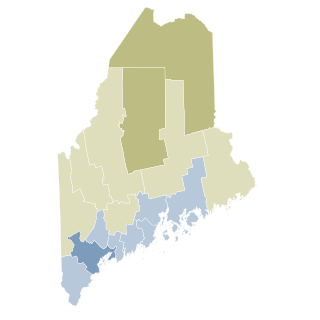
In California, a ballot proposition is a referendum or an initiative measure that is submitted to the electorate for a direct decision or direct vote. If passed, it can alter one or more of the articles of the Constitution of California, one or more of the 29 California Codes, or another law in the California Statutes by clarifying current or adding statute(s) or removing current statute(s).
In the politics of the United States, the process of initiatives and referendums allow citizens of many U.S. states to place new legislation, or to place legislation that has recently been passed by a legislature on a ballot for a popular vote. Initiatives and referendums, along with recall elections and popular primary elections, are signature reforms of the Progressive Era; they are written into several state constitutions, particularly in the West. It is a form of direct democracy.
Robert F. Hagan is an American politician and member of the Democratic Party who held a seat in the Ohio House of Representatives for the 58th District from 2007 to 2014. He represented the same seat from 1987 to 1997, and served in the Ohio Senate from 1997 to 2006.
Electoral reform in Virginia refers to efforts to change the electoral system in the Commonwealth of Virginia. Virginia has undergone much electoral change since its settling in 1607, many of which were required by federal legislation. However, it remains a relatively conservative state in this respect compared to California and others which have experimented with various alternative systems.

Elections in Oregon are all held using a Vote by Mail (VBM) system. This means that all registered voters receive their ballots via postal delivery and can vote from their homes. A state Voters’ Pamphlet is mailed to every household in Oregon about three weeks before each statewide election. It includes information about each measure and candidate in the upcoming election.
Same-sex marriage has been legally recognized in Maine since December 29, 2012. A bill for the legalization of same-sex marriages was approved by voters, 53–47 percent, on November 6, 2012, as Maine, Maryland and Washington became the first U.S. states to legalize same-sex marriage by popular vote. Election results were certified by the Maine Secretary of State's office and the Governor of Maine, Paul LePage, on November 29.

The 2009 Washington Referendum 71 (R-71) legalized domestic partnership in Washington state, the first statewide referendum in the United States that extended to LGBT people the rights and responsibility of domestic partnership. The bill had passed State Legislature, and it was signed into law by the Governor in May 2009, but opponents gathered enough signatures to put the measure before the voters, who returned ballots by mail over three weeks ending on November 3, 2009, approving the measure 53% to 47%. The new law went into effect 30 days later, on December 3, 2009.

Matt Huffman is an American politician serving as a member of the Ohio Senate, representing the 12th district since 2017, while concurrently serving as the Ohio Senate President as a Republican. The district includes Allen, Champaign, Mercer and Shelby counties, as well as parts of Auglaize, Darke and Logan counties.
The No Sales Tax for Alcohol Question, also known as Question 1, was on the November 2, 2010 ballot in Massachusetts. The measure asked voters whether to repeal a sales tax on alcohol sales. The ballot measure for the 2010 ballot was added after the Massachusetts State Legislature increased the sales tax in the state from 5% to 6.25% and eliminated an exemption for alcohol sold in liquor stores.

Maine Question 1 was a voter referendum conducted in Maine in the United States in 2009 that rejected a law legalizing same-sex marriage in the state. The measure passed 53–47% on November 3, 2009.

Recall elections for nine Wisconsin state senators were held during the summer of 2011; one was held on July 19, and six on August 9, with two more held on August 16. Voters attempted to put 16 state senators up for recall, eight Democrats and eight Republicans, because of the budget bill proposed by Governor Scott Walker and circumstances surrounding it. Republicans targeted Democrats for leaving the state for three weeks to prevent the bill from receiving a vote, while Democrats targeted Republicans for voting to significantly limit public employee collective bargaining. Scholars could cite only three times in American history when more than one state legislator has been recalled at roughly the same time over the same issue.
Fair, Accurate, Inclusive, and Respectful Education Act, also known as the FAIR Education Act and informally described by media outlets as the LGBT History Bill, is a California law which compels the inclusion of the political, economic, and social contributions of persons with disabilities and lesbian, gay, bisexual, and transgender people into educational textbooks and the social studies curricula in California public schools by amending the California Education Code. It also revises the previous designation of "black Americans, American Indians, Mexicans, Asians, [and] Pacific Island people" into a list considered Indigenous peoples of the Americas. It would also amend an existing law by adding sexual orientation and religion into a list of characteristics that schools are prohibited from sponsoring negative activities about or teaching students about in an adverse way.

Frank LaRose is an American politician. He was elected Secretary of State of Ohio in 2019. He was a Republican member of the Ohio State Senate for two terms, from January 2011 to January 2019. He is a candidate for the U.S. Senate in the 2024 election, challenging incumbent Senator Sherrod Brown.

Maine Question 1 was a voter referendum on an initiated state statute that occurred on November 6, 2012. The referendum was held to determine whether or not to legalize same-sex marriage. The referendum passed with a 53-47% vote legalizing same-sex marriage in Maine.
The Massachusetts Automatic Gas Tax Increase Repeal Initiative, Question 1 was on the November 4, 2014 statewide ballot. Approved by voters, the measure repeals a 2013 law that would automatically adjust gas taxes according to inflation, allowing for automatic annual increases in the state's gas tax.

Maine Question 1 was a people's veto referendum that appeared on the June 12, 2018 statewide ballot. It sought to reject a law passed by the Maine Legislature that suspended the implementation of ranked choice voting, authorized by Maine voters in a previous referendum, for use in Maine elections until and if an amendment to the Maine Constitution is passed to expressly permit it; failing that, the law would be automatically repealed in 2021. It qualified because supporters of the original referendum collected the necessary number of signatures from registered Maine voters. This vote coincided with primary elections in which party nominees for governor, U.S. Senate, U.S. House, and the Maine Legislature were chosen through RCV to run in general elections on November 6.

Maine Question 1, "Do you want to reject the section of Chapter 399 of the Public Laws of 2011 that requires new voters to register to vote at least two business days prior to an election?", was a 2011 people's veto referendum that rejected a bill repealing Election Day voter registration in Maine. The vote was held on November 8, 2011 after being placed on the ballot due to supporters collecting the necessary number of signatures. The veto effort was successful, with 237,024 votes in favor of repeal to 155,156 against repeal.

California Proposition 6 was a measure that was submitted to California voters as part of the November 2018 election. The ballot measure proposed a repeal of the Road Repair and Accountability Act, which is also known as Senate Bill 1. The measure failed with about 57% of the voters against and 43% in favor.

A general election was held in the U.S. state of Illinois on November 8, 2022. The elections for United States Senate and United States House of Representatives, Governor, statewide constitutional officers, Illinois Senate, and Illinois House were held on this date.












